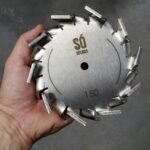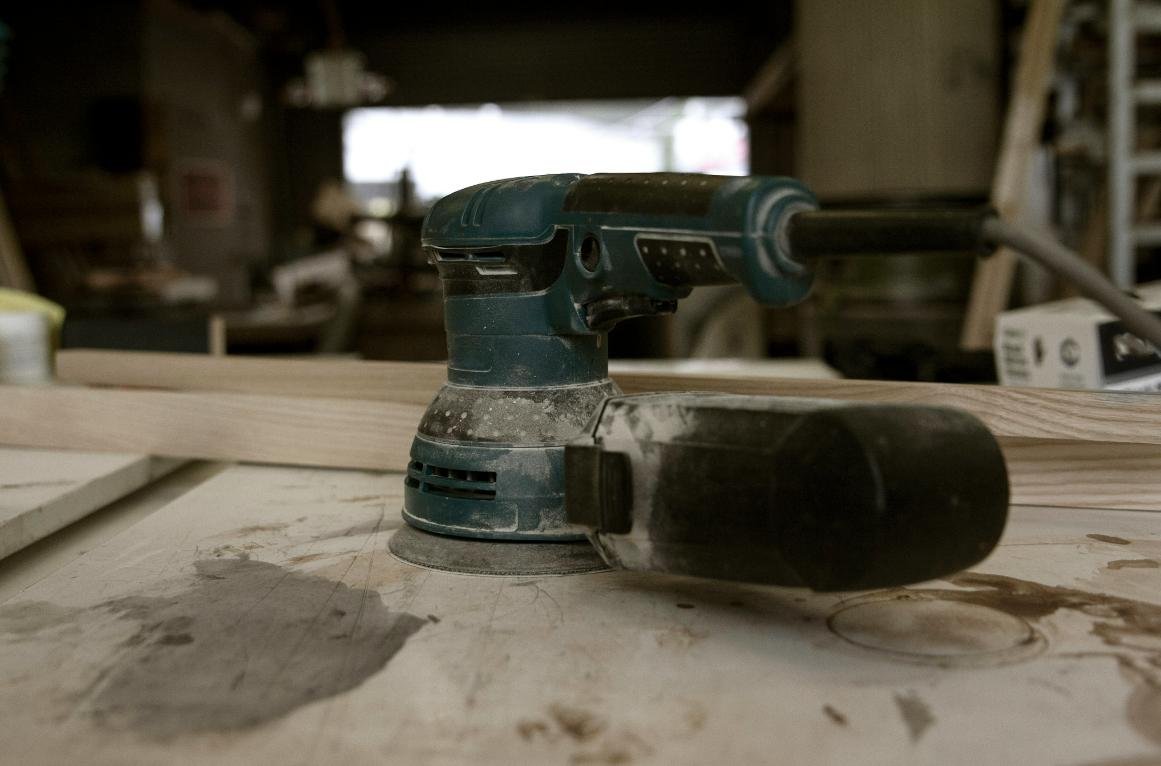Introduction to Sanders
Sanders are essential power tools in both woodworking and DIY projects, designed primarily to smooth and finish surfaces. Their primary function revolves around the use of abrasive materials to remove surface imperfections, whether it be rough edges, blemishes, or paint residues. By achieving a fine finish, sanders not only enhance the aesthetic appeal of a project but also prepare surfaces for further applications, such as painting or varnishing.
Within the realm of sanders, two prominent types stand out: orbital sanders and finishing sanders. Each type of sander operates based on distinct mechanisms and serves particular purposes, making the choice of tool vital to achieving desired results. Orbital sanders utilize a circular sanding pad that moves in an elliptical motion, allowing for extensive coverage and efficient material removal. This makes them ideal for larger surfaces and initial sanding tasks. Conversely, finishing sanders are designed for finer detail work, employing a rectangular pad that allows for precision in sanding corners and edges. Their ability to deliver a smooth, even finish makes them a favored choice for the final stages of a project.
Understanding the differences between these two sanders is crucial for anyone engaged in woodworking or home improvement. When selecting a sander, one must consider the specific requirements of the task at hand. For example, if the goal is to quickly remove material from a substantial surface, an orbital sander would be more appropriate. However, for intricate work requiring finesse, a finishing sander would be the better option. Therefore, familiarity with the functionality and versatility of each type of sander is imperative in order to ensure optimal results in any woodworking endeavor.
What is an Orbital Sander?
An orbital sander is a versatile power tool designed primarily for smoothing and finishing wood surfaces, making it an essential tool in woodworking and DIY projects. These sanders utilize a circular sanding disk that moves in an orbital pattern, allowing for a unique combination of rotational and linear sanding motion. This design reduces the risk of deep scratches and swirl marks, resulting in a smoother finish. Orbital sanders are available in two main types: random orbit sanders and standard orbit sanders.
Random orbit sanders feature a unique mechanism that combines both circular rotation and orbital motion. This means that the sanding pad moves in a circular fashion while simultaneously orbiting in a larger circle. The random pattern of movement reduces the appearance of swirl marks, which is a common concern when sanding. This type of sander is particularly effective for tasks that require a smooth surface finish, such as preparing wood for staining or painting. It is also suitable for sanding curved surfaces, making it a preferred choice among professional woodworkers and hobbyists alike.
On the other hand, standard orbit sanders, also referred to as quarter-sheet sanders, operate with a more traditional sanding motion. They grip a square or rectangular sheet of sandpaper and move it in small, circular or elliptical motions. While they are less versatile than their random orbit counterparts, standard orbit sanders excel in detailed work on flat surfaces, such as sanding down edges or corners. The design of an orbital sander allows for significant material removal while maintaining an even surface, making it an ideal selection for various woodworking tasks, such as smoothing surfaces and preparing them for further finishing processes.
What is a Finishing Sander?
A finishing sander, also known as a detail sander or palm sander, is a handheld power tool specifically designed to achieve a smooth and refined surface finish on wood and other materials. Unlike more aggressive sanders, such as belt or orbital sanders, finishing sanders operate at lower speeds and utilize a lightweight design, making them ideal for delicate work and intricate projects.
The primary function of a finishing sander is to prepare surfaces for further treatment, such as staining or painting. It accomplishes this task by utilizing a rectangular or triangular sanding pad that accommodates high-grit sandpaper. The sandpaper used in a finishing sander is generally finer than that employed in heavier sanding tasks, allowing for precision in smoothing down the surface without deep scratching or damaging the material. This capability is particularly advantageous when working with finishes where an immaculate appearance is paramount.
Finishing sanders operate using an orbital sanding motion, which means the pad moves in a circular, vibrating pattern while simultaneously moving in slight elliptical orbits. This dual-action helps to create a smoother finish without the risk of creating visible swirl marks or uneven surfaces. Additionally, the lightweight and compact design of finishing sanders allows for easy maneuverability, enabling users to reach tight corners and intricate details of their projects effortlessly.
In practice, finishing sanders are commonly used for tasks such as sanding down the final surface of furniture, preparing cabinets for staining, or refining wooden trim and moldings. Their unique design and operational mechanism make them an essential tool for woodworkers and DIY enthusiasts seeking to achieve professional-grade results in their projects.
Comparative Analysis: Orbital vs Finishing Sanders
When evaluating sanding tools, two prominent options are orbital sanders and finishing sanders. Both serve the essential function of smoothing surfaces, yet they possess distinct characteristics that cater to different user needs and material types. Understanding these differences can significantly influence project outcomes.
Orbital sanders employ a circular sanding disc that rotates in a random pattern, which enables them to tackle larger surface areas more efficiently. This design promotes a smoother finish with reduced chances of visible sanding marks. Their higher sanding speed makes them particularly effective for various materials, including wood, metal, and plastic. This versatility allows users to achieve consistent results across different projects, making them a popular choice among both professionals and DIY enthusiasts.
In contrast, finishing sanders are characterized by their rectangular shape and a focus on final touch-ups. The pad typically moves in a simple back-and-forth motion, allowing for precision sanding in tighter corners and edges. While their speed is lower compared to orbital sanders, they excel at providing a fine finish, especially on softer woods and delicate materials. The lower sanding speeds of finishing sanders can minimize the risk of over-sanding and damaging the surface. This feature is crucial for those who prioritize detail and surface quality.
User experience also differs between the two tools. Orbital sanders often require less exertion during operation due to their ergonomic design and lighter weight, making them more suitable for extended sanding tasks. Conversely, finishing sanders, although requiring more manual effort, provide enhanced control, making them ideal for intricate work.
Ultimately, the choice between orbital and finishing sanders depends on the specific requirements of a project. By thoroughly assessing the materials involved, desired finish, and work style, users can select the most appropriate sanding tool for optimal results.
Ideal Use Cases for Orbital Sanders
Orbital sanders are versatile power tools that are ideally suited for a variety of projects where efficient material removal and a smooth finish are required. One of the most common applications for orbital sanders is floor refinishing. When refurbishing hardwood floors, an orbital sander can swiftly remove the old finish and flatten any imperfections in the wood surface, preparing it for a new coat of varnish or stain. The random orbit motion ensures that the sander does not leave swirl marks, resulting in a professional-looking finish.
Another scenario where orbital sanders excel is in the preparation of rough or irregular surfaces. For example, when working with reclaimed wood or other salvaged materials, an orbital sander can effectively smooth out surfaces that may have splinters or rough patches. This type of sander can also be beneficial in larger-scale projects, such as working on custom furniture pieces. An orbital sander allows woodworkers to tackle broad areas quickly without compromising the quality of the surface finish.
In addition to these applications, orbital sanders are also perfect for tasks that require a fine touch, such as sanding between finish coats. Their ability to produce a uniform surface makes them suitable for delicate work, including finishing cabinets or intricate moldings. Furthermore, orbital sanders are often favored for their lightweight design and ease of maneuverability, allowing users to work comfortably for extended periods.
Considering these ideal use cases, it is clear that orbital sanders are a valuable asset for both professional woodworkers and DIY enthusiasts alike, making them indispensable for various sanding tasks.
Ideal Use Cases for Finishing Sanders
Finishing sanders are specifically designed for projects that require a high-quality, smooth surface. Their lightweight construction and finer grit paper make them especially suitable for applications where a delicate touch is essential. One of the primary use cases for finishing sanders is in cabinet making. When crafting cabinets, achieving a refined finish is not just a preference but a necessity. The smooth surface not only enhances the aesthetic appeal but also prepares the wood for staining or varnishing, ensuring a polished final product.
Another scenario where finishing sanders excel is when working on intricate details in furniture making. Projects that involve detailed carvings or fine edges benefit greatly from the precision that finishing sanders provide. These tools can efficiently sand tight corners and contours without damaging surrounding areas, thereby preserving the integrity of the design. The use of a finishing sander is crucial in ensuring that no area is overlooked, providing a consistent surface that highlights the craftsmanship of the piece.
Furthermore, any work involving delicate finishes, such as those found in restoration projects or crafts, is best suited for finishing sanders. These sanders minimize the risk of oversanding, which can lead to surface imperfections. For instance, when restoring antique furniture, it is imperative to retain as much of the original surface as possible, making a finishing sander an ideal choice. With their gentle sanding action, finishing sanders ensure that the underlying wood remains intact while still achieving the smoothness desired for optimal application of finishes.
In light of these considerations, it becomes clear that finishing sanders are invaluable tools for specific applications, particularly where a refined finish is paramount.
Pros and Cons of Orbital Sanders
Orbital sanders are popular tools for both professionals and DIY enthusiasts, primarily due to their efficiency in sanding surfaces. One major advantage of using an orbital sander is its speed; it allows users to complete sanding tasks quickly, thereby increasing productivity. This tool is particularly effective for flattening surfaces and removing paint or finishes, making it suitable for various woodworking projects.
Another significant benefit of orbital sanders is their versatility. With various grades of sandpaper available, they can tackle a range of tasks from coarse sanding to finishing touches. This adaptability makes them useful for both rough and fine carpentry, as well as for preparing surfaces for painting or varnishing. Additionally, the design of an orbital sander minimizes swirls and scratches, resulting in a smoother finish compared to some other sanding methods.
Ease of use is another advantage to consider. Many orbital sanders are designed with user-friendly features and ergonomic grips that enhance comfort during prolonged usage. This aspect makes them particularly appealing to individuals who may not have extensive experience with power tools.
However, there are also downsides associated with orbital sanders. One of the notable negatives is the noise level, which can be disruptive during extended projects. Moreover, if an orbital sander is not operated carefully, it can potentially damage surfaces, particularly softer woods. Users must be mindful of applying excessive pressure, as this can lead to sanding through the material or creating uneven surfaces. Such risks underscore the importance of technique and control when using this power tool.
Ultimately, while orbital sanders offer many advantages—such as speed, versatility, and ease of use—they also come with potential drawbacks like noise and risk of damage. Users should weigh these factors carefully when considering an orbital sander for their projects.
Pros and Cons of Finishing Sanders
Finishing sanders are specialized power tools designed to create smooth surfaces on wood and other materials. They excel in providing a finely detailed finish, making them an ideal choice for delicate projects. One of the primary benefits of using a finishing sander is the precise control it offers. Users can maneuver the tool effectively in tight spaces and on intricate designs, where larger sanders may struggle. The compact design and lightweight nature of these sanders facilitate easier handling, resulting in higher quality finishes on furniture, cabinetry, and detailed woodworking.
Another noteworthy advantage of finishing sanders is their ability to produce a superior level of smoothness. They are equipped with finer grits of sandpaper, allowing them to remove minor imperfections, splinters, and rough patches while leaving a clean surface ready for staining or painting. This feature is particularly valuable for those projects requiring a polished appearance, helping to ensure the final product meets aesthetic standards.
However, finishing sanders have their drawbacks. One significant limitation lies in the sanding speed. These devices operate at a slower rate than more robust sanders, such as orbital sanders, which can render them less effective for larger surfaces or for tasks requiring rapid material removal. Additionally, while finishing sanders excel on smooth surfaces, they struggle on rough or uneven materials. In such cases, the slow pace and inadequate power may lead to an increased time investment to achieve the desired finish.
In conclusion, finishing sanders are best suited for projects needing precision and finesse. Their advantages, including fine control and a premium finish, are balanced by their slower operation and reduced capacity to handle rough surfaces. When selecting a sander, it’s essential for woodworkers to consider the specific requirements of their project to determine if a finishing sander is the appropriate choice.
Conclusion: Choosing the Right Sander for Your Project
Selecting the appropriate sander can significantly influence the outcome of your woodworking or refinishing project. Throughout this discussion, we have explored the key differences between orbital sanders and finishing sanders, highlighting their unique applications and functions. When deciding which tool to invest in, it is essential to contemplate the nature of your tasks and the desired finish.
Orbital sanders excel in removing material quickly and efficiently, making them ideal for larger projects or when precision is less critical. Their random orbit motion helps minimize swirl marks, resulting in a relatively smooth surface. They are highly versatile, suitable for various surfaces, including wood, metal, and plastics, and work well for both rough and finer sanding tasks.
On the other hand, finishing sanders are designed primarily for achieving a fine surface finish, particularly on wood. Their smaller size and specialized design allow for greater control, enabling users to work in tighter spaces or on intricate details. If your project demands a delicate touch, such as preparing furniture for staining or applying a smooth finish prior to painting, a finishing sander might be the better choice.
Ultimately, the decision between an orbital sander and a finishing sander should be guided by your specific project needs. Assess the scale of the work, the types of materials involved, and the finish quality you desire. It is also beneficial to consider your familiarity with each tool, as personal comfort and experience can enhance your efficiency and the quality of your results. By carefully evaluating these factors, you can determine which sander will best serve your woodworking endeavors.






